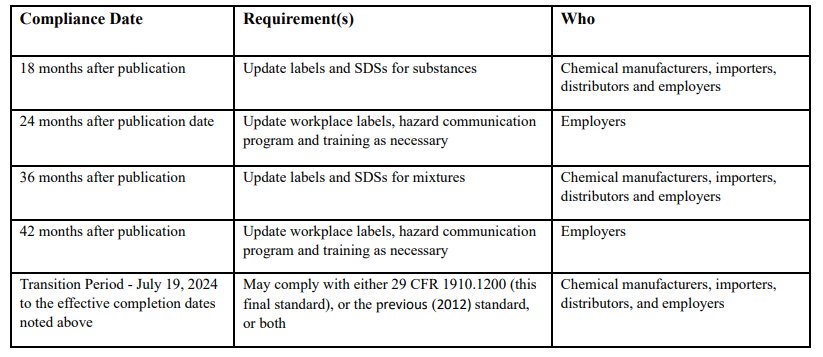OSHA’s Updated Hazard Communication Standard Takes Effect July 2024
Posted by Clarion Safety Systems | 24th Jun 2024

The Department of Labor has announced a final rule from the Occupational Safety and Health Administration (OSHA) to update the agency’s Hazard Communication Standard (HCS). The aim is to better inform employees about chemical hazards in the workplace. The rule does this by improving the quality and accessibility of information on chemical labels and safety data sheets (SDS).
Effective Date: July 19, 2024
The revised HCS, published
in May and taking effect later this summer on July 19, aligns primarily with the seventh revision of the United Nations'
Globally Harmonized System of Classification and Labelling of Chemicals
(GHS).
Here's a breakdown of key changes in the updated standard:
- Enhanced Information on Labels and SDS: Labels on even small containers will be more comprehensive and readable, ensuring workers have crucial hazard information readily available. The update also addresses trade secret concerns, ensuring critical safety information remains accessible on SDS.
- Clearer Hazard Classification: A revised classification process will provide more complete and accurate hazard information on both labels and SDS. This empowers workers to understand the chemicals they handle and make informed decisions.
- Improved Physical Hazard Classes: Updates to physical hazard classifications aim to better inform workers on the safe handling of explosives, aerosols, and chemicals under pressure.
- Streamlined Precautionary Statements: Clearer instructions on handling, storing,
and disposing of hazardous chemicals will be provided through updated
precautionary statements.
You can view a streamlined side by side comparison of OSHA’s changes from the HCS 2012 version to HCS 2024 on their website.
Addressing Past Issues and
Promoting Alignment
The revised HCS also tackles concerns identified since the 2012 update.
Additionally, it fosters better alignment with other federal agencies and
Canada, promoting a more unified approach to workplace chemical safety across
North America.
Preparing for the Change
OSHA is giving chemical manufacturers, importers and distributors from January
19, 2026 to July 19, 2027 to comply with the new rules, depending on if they’re
evaluating substances or mixtures. Employers using products covered under the
standard must update their hazcom programs, labeling, and employee training by
July 20, 2026, or January 19, 2028, depending on substances or mixtures.
During this transition period, consider these proactive steps:
- Review Your Hazard Communication Program: Ensure your program is current, or that you
have a plan in place to ease into compliance. There is a tiered compliance list
based on your establishment which is as follows:

- Evaluate Your Safety Signage and Labels: Confirm your signage and labels comply with the new GHS requirements. Clarion Safety offers GHS-compliant labels and signs.
- Schedule a Risk Assessment: A comprehensive risk assessment from Clarion Safety’s team can identify potential hazards associated with the machinery in your workplace and ensure appropriate controls are in place.
Clarion Safety: Your Partner in
Workplace Safety
The revised HCS emphasizes clear communication of chemical hazards. By
partnering with Clarion Safety, you can ensure your workplace is prepared for
the upcoming changes and prioritize worker safety. We offer a variety of
equipment and workplace safety labels and signs for worker protection, as well as hazard and risk analysis options for a variety of machines and work areas. Reach out to
our team today!